A mixed group go on a trip trip to Frances Cottage, Chambe on Mulanje Mountain. I first published this blog post here in 2011. Does a small group of young adults and a young family work for a trip like this? Why not?
.........................................................................................
The first step, well the first step for me at least, is to find people to climb Mulanje with. One reason for that is the number one rule on Mulanje - don't climb alone. Also, the point of climbing Mulanje is to enjoy it, so therefore best to share the fun.
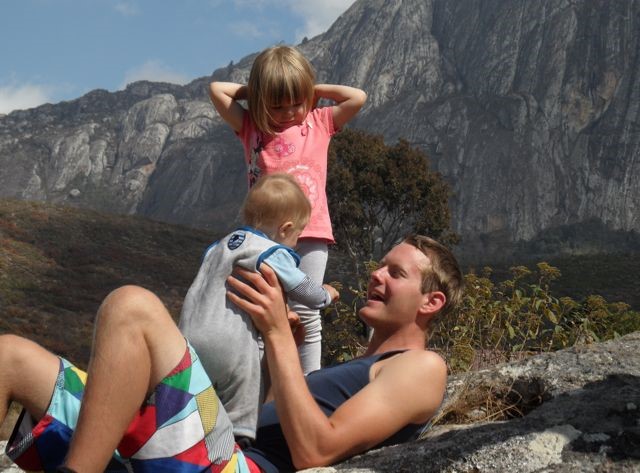 Go in a group and enjoy the company of others on Mulanje. It is a great environment for becoming good friends with people outside of your usual social circle.If you don't have anyone you know to climb Mulanje with and don't have time to wait for the right person to come along, then climb with a porter and / or guide. Mike Petzold in 'The Peaks of Mulanje Mountain' lists 59 peaks and tops. He says that he has been on the top of all but three of them, some of them several times, 'but NEVER alone.' If one of the most experienced Mulanje people is NEVER alone up there - then perhaps consider that the advice has merit.
Go in a group and enjoy the company of others on Mulanje. It is a great environment for becoming good friends with people outside of your usual social circle.If you don't have anyone you know to climb Mulanje with and don't have time to wait for the right person to come along, then climb with a porter and / or guide. Mike Petzold in 'The Peaks of Mulanje Mountain' lists 59 peaks and tops. He says that he has been on the top of all but three of them, some of them several times, 'but NEVER alone.' If one of the most experienced Mulanje people is NEVER alone up there - then perhaps consider that the advice has merit.
Upon arrival in Malawi I was a little bit disappointed to find some difficulty in finding people who wanted to climb Mulanje. For most people there is the Mountain Club of Malawi who often have people going up. You can join if you are a resident in Malawi. Because we have young children I had in mind other families with young children or beginners who would be happy to climb slowly. I come from the point of view that going to Malawi and not climbing Mulanje is like going to Paris and not seeing the Eiffel Tower. I was told of a tour group in Malawi that was neither going up Mulanje nor to the Lake. All I could do was stare at the person who told me this for a while - I did not know what to say. I think I am still adjusting to the way some western visitors think about Malawi compared with how we thought about and enjoyed Malawi when I was a child.
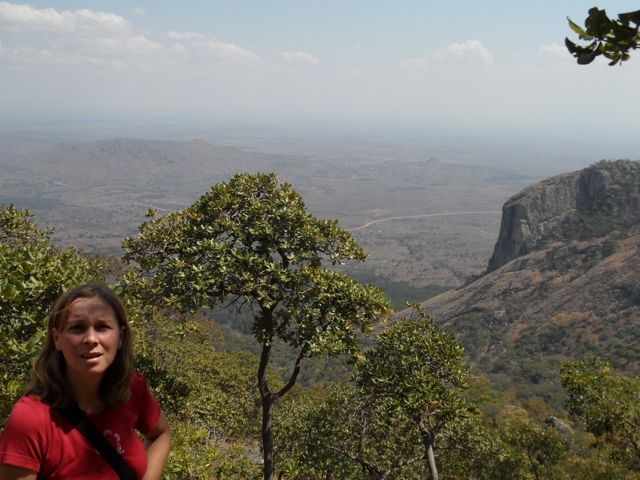 When climbing to the plateau look down to see your progressSomeone I played football with at primary school told me that the kind of westerners who are in the country now are different to those around when we were children.
When climbing to the plateau look down to see your progressSomeone I played football with at primary school told me that the kind of westerners who are in the country now are different to those around when we were children.
"There are far more short-term people here and far fewer westerners living here for the long term."
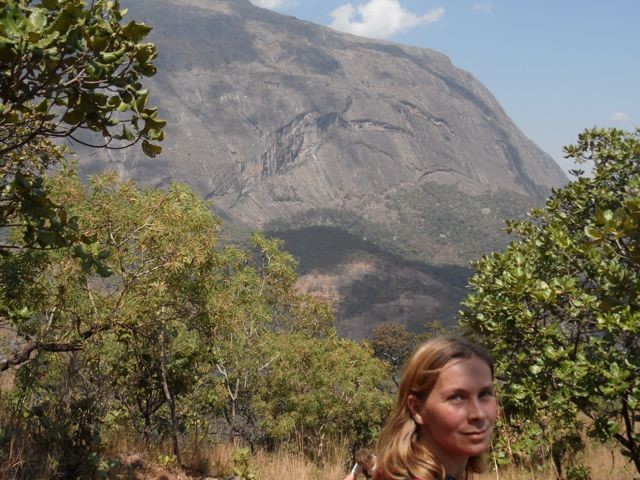 When climbing to the plateau look up for inspiration
When climbing to the plateau look up for inspiration
That affects things of course. One of my dreams on coming here was to enjoy Malawi the way we enjoyed Malawi a long time ago. That requires others to come to appreciate and share doing these things - another part of my dream. Don't get me wrong - a lot of the new things and new ways of doing things in Malawi are fantastic. However, they don't need to replace the wisdom of the past - they simply add to the already infinite appeal of Malawi. Can one add to the infinite appeal of Malawi? Of course. Perhaps considering this point helps us think about the full hotel with an infinite number of rooms.
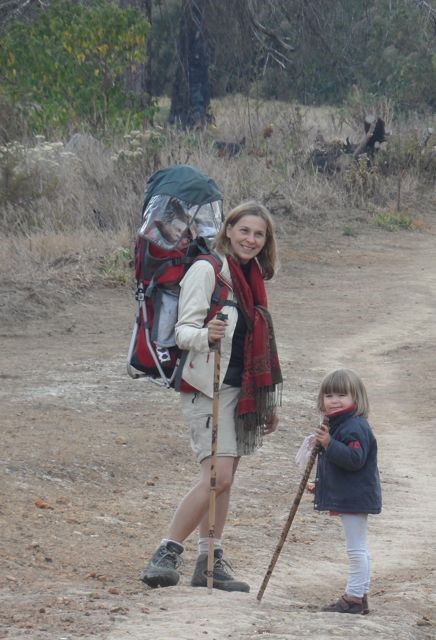 Enjoy Mulanje with othersClimbing Mulanje is one of those things that is best done with some knowledge of what you are doing and why. The mistake with Mulanje is to treat it as just another mountain and simply climb up to the top and then climb back down.
Enjoy Mulanje with othersClimbing Mulanje is one of those things that is best done with some knowledge of what you are doing and why. The mistake with Mulanje is to treat it as just another mountain and simply climb up to the top and then climb back down.
On the Ilala ferry coming back from Likoma Island I was waxing lyrical to other passengers about the wonders of Mulanje Mountain. Usually when this sort of thing happens my listeners and friends roll their eyes and stiffen their resolve to avoid whatever good idea I may be suggesting. So I was quite surprised when Eerik from Finland seemed to be persuaded by my propaganda. I cautiously then suggested that perhaps we could climb the mountain together. Pessimistically I asked Amelia for her opinion and to my surprise she was agreeable and thought that it would make a good family outing. Given Eerik's timetable we would have to go soon. After returning to dry land we stopped in Zomba to meet some Romanian people we had heard about. They had an lodger from Northern Ireland (David) and when he heard about our trip he decided to join us. Like us he had been looking for an opportunity. No sooner had we got to Blantyre than a friend mentioned that he knew someone who wanted to climb Mulanje. So Matthew from Australia became the final member of our small party.
The next steps involve contacting the Forestry Office and booking a hut, dealing with the Mountain Club if you are a member and buying all the food that you need for your time on the mountain. There is a good article in the Mountain Club of Malawi Golden Jubilee Journal by Sue Miller called 'Dietary Deliberations'. The subject matter is a practical guide on how to eat well for several days.
On the day of the climb (Friday) David planned to join us from Zomba. He had an appointment the night before so said he would get the 5am bus to Blantyre. We did not have room in our Rav4 for Eerik (now in Blantyre) or Matthew so they were getting an early bus from Limbe to Mulanje town. I dropped them near a minibus and then headed back to collect the rest of the family and wait for David. Unfortunately poor David had to wait until well after six am for his minibus to depart - the joys of public transport. Rather than wait for his arrival in Blantyre we decided to intercept his minibus in Limbe which was an adventure in itself.
We stopped at infoMulanje in Mulanje town and found that Eerik and Matthew had already departed on the next leg of public transport to Likhubula and the forestry office. That is the most unpredictable leg on public transport due to the infrequency of connections. Three of the paths to the plateau originate at the Forestry Office so if you have some people in your group who are lacking private transport it can be less complicated to climb from here than from some of the alternatives. [UPDATE: Since this blog post was written this start point has become much less popular among Malawi residents when compared with the many alternatives]. This is the place where you finalise arrangements for huts, porters, a guide if necessary and payments. If you are in the Mountain Club of Malawi it is a little different as instead payments are made through them - including the forestry reserve entrance fee.
Finally at Likhubula we met up again with Eerik and Matthew, neither of whom were hiring porters. Eerik explained that he was recently in the Finnish army so had no need of this kind of assistance. In total we hired five porters - two of whom would carry Ruth and baby David. Typically porters will deposit your food and heavy rucksacks at the mountain hut long before you reach the plateau but in this instance we asked the porters to stay with us - David often needs his mummy.
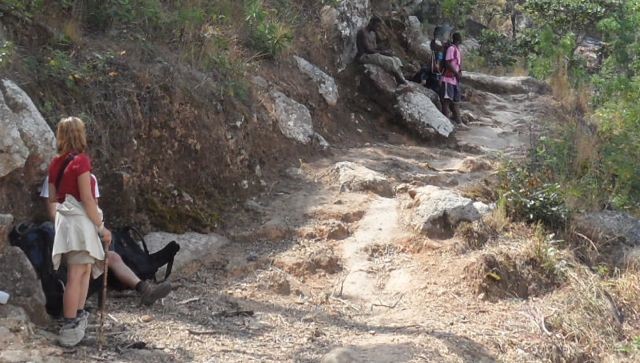 A stop. David and the porter carrying him are a little ahead of us.
A stop. David and the porter carrying him are a little ahead of us.
Matthew, Eerik and big David hired a guide as they planned to climb Sapitwa the next day. I am still trying to get used to the idea of guides as I have climbed Sapitwa three times myself without the thought of a guide even entering my head. However, I am told that these days the 'red route' up Sapitwa is faded and incomplete and a guide is now necessary. The red route was painted arrows on rocks on Sapitwa that guided climbers up Sapitwa. Sapitwa covers a big area and does not lend itself well to paths. The wilderness of boulder fields and other unusual features mean that getting lost on Sapitwa is a real possibility. Yasseen from the mountain club warned us that the last person to attempt Sapitwa without a guide lost his life. If the red route is now faded then a guide is certainly necessary for Sapitwa.
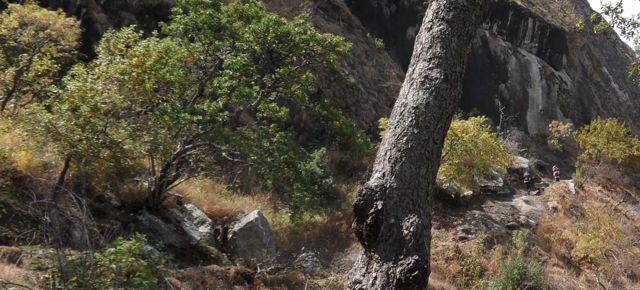 These porters are getting further away
These porters are getting further away
I often find that the hardest parts of a climb are the first few steps - or restarting after a stop. The previous time I had climbed Mulanje the porters we had booked the previous day were no where to be seen at the agreed time and place. Therefore I and my brothers found ourselves carrying about two rucksacks each and by the time the porters caught us (two thirds of the way to the plateau). I was beginning to think that we would in fact make it.
This time around Amelia kept on asking if we were half-way yet. Each time she asked I scoffed but in fact we were on the plateau sooner than I had expected. Looking at my guide book later I realised that the climb we were more accustomed to (to Thuchila Hut) was to a part of the plateau several hundred feet higher than Chambe Basin - our current destination. [UPDATE: There are a couple of paths I usually recommend for people who want to do one of the slightly less demanding ascents to the plateau].
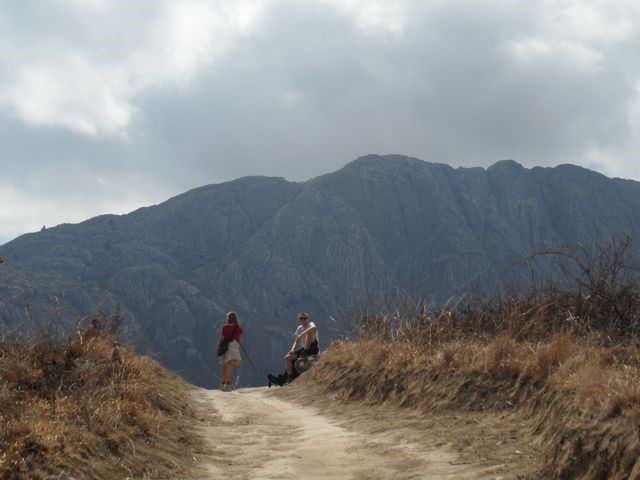 The plateau at last Chambe peak the 20th highest on the mountain is in the background
The plateau at last Chambe peak the 20th highest on the mountain is in the background
I was quietly satisfied to see how pleased porter-less Eerik was on reaching the plateau and to hear him admit that he had 'under-estimated Mulanje'. Also, on the edge of the plateau I was happy to note that the guide informed us that the spectacular Chambe peak next to us is the 'second highest peak on Mulanje'. It is not, it is the twentieth highest peak on Mulanje Mountain. I have nothing against guides. What does irritate me however is being lectured to by excitable Malawi 'experts' who have been in the country for five minutes about the absolute necessity of taking a guide. Of course I don't put Yasseen in this category. Yasseen is quite right, if you don't know Sapitwa very well and the red route is faded - then take a guide. Otherwise on Mulanje, and there is a lot more to Mulanje, why not take a map, a compass, friends, people who know the mountain a little, a sense of adventure and the ambition to explore and discover without having your hand held? [UPDATE: Since I first wrote that my views have matured slightly. :-) It is all very well being self sufficient if you know the mountain and know others who do to. If you are just visiting the country then even if you want to be independent there is a lot of wisdom in taking someone who knows the mountain well. In many cases porters may well be sufficient for this].
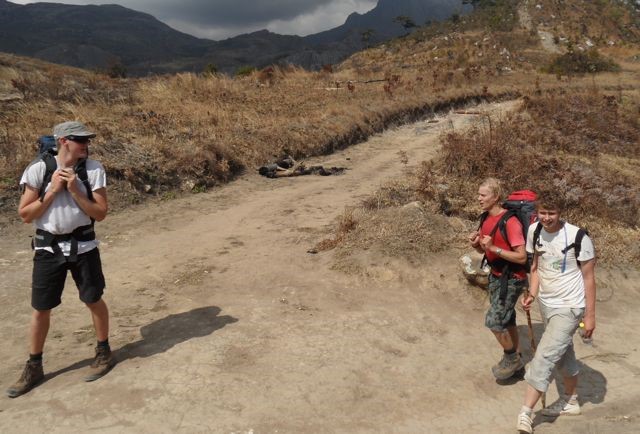 Eerik (blond) is pleased to reach the plateau as is David. Matthew seems to be half waiting and half 'let's get on to the cottage'.By the time we reached the plateau there were other thoughts on our minds. We had not seen Ruth or David for perhaps an hour or more? We had not timed it. Amelia said that it was the longest period of time that David had been away from his mother. Although we had asked the porters carrying the two little ones to stay with us they had not managed to keep strictly to this request for the whole trip. We speculated that they could be upset now in an unfamiliar setting, with unfamiliar people and no mummy or daddy in sight. On the plateau therefore we tried to up our pace as France's Cottage is still a significant walk across the Chambe Basin. Finally we got there and they seemed perfectly happy. Ruth wanted to show us around. [NOTE: Porters going on ahead is a common grumble even when there has been an apparent agreement to stay together. The official porters and guides list has got a lot longer recently but we think it is better if the porters are familiar to those climbing or to those who are helping visitors with their plans].
Eerik (blond) is pleased to reach the plateau as is David. Matthew seems to be half waiting and half 'let's get on to the cottage'.By the time we reached the plateau there were other thoughts on our minds. We had not seen Ruth or David for perhaps an hour or more? We had not timed it. Amelia said that it was the longest period of time that David had been away from his mother. Although we had asked the porters carrying the two little ones to stay with us they had not managed to keep strictly to this request for the whole trip. We speculated that they could be upset now in an unfamiliar setting, with unfamiliar people and no mummy or daddy in sight. On the plateau therefore we tried to up our pace as France's Cottage is still a significant walk across the Chambe Basin. Finally we got there and they seemed perfectly happy. Ruth wanted to show us around. [NOTE: Porters going on ahead is a common grumble even when there has been an apparent agreement to stay together. The official porters and guides list has got a lot longer recently but we think it is better if the porters are familiar to those climbing or to those who are helping visitors with their plans].
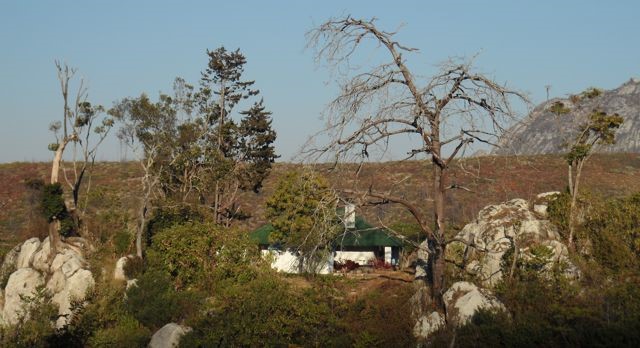 Frances Cottage as seen from Chambe Hut
Frances Cottage as seen from Chambe Hut
On the way down three days later we asked the down porters to stay with us and they did and they were also good conversation. They left us their details and did say that it would be OK to make private arrangements with them - they are of course registered porters. It is best to go with the Forestry Department's official porter rota and follow the Mountain Club guidelines so I may well ask the MCM about whether we can pick porters we know for carrying the children as it is better if we can have porters who when carrying the children do stay at our pace. [ANOTHER UPDATE...SORRY: this subject has developed since this blog post was written. This is for various reasons best not gone into right now. All I'd say is that there have been failures to agree on certain points in more recent meetings between the Mountain Club and the Porters and Guides Association. This should not put anyone off the idea of climbing Mulanje however.]
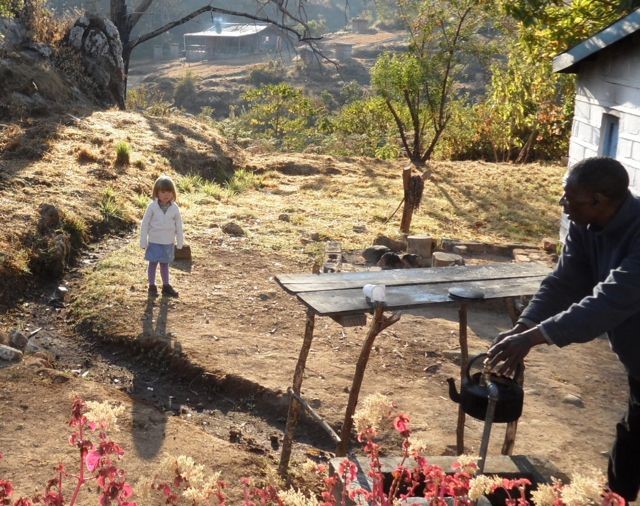 Chambe Hut in the background from Frances Cottage
Chambe Hut in the background from Frances Cottage
After settling in we visited the neighbouring Chambe Hut where we had spotted some (older) children there for Ruth to play with. Sensibly that family had taken their children up the Potato Path to Zomba Plateau on a couple of occasions as training for their little ones (and to verify that they can actually climb a mountain). I thought it was a very good idea and from now on if I meet someone who is unsure of whether they are fit enough to climb Mulanje I will suggest that they climb the Potato Path on Zomba Plateau first.
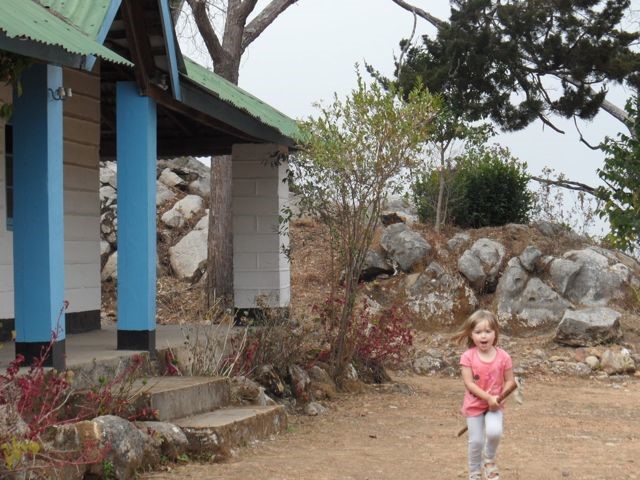 Ruth plays outside the front of Frances Cottage
Ruth plays outside the front of Frances Cottage
Later we discussed the news that the guide wanted to set off at 4am with the three guys who were going to climb Sapitwa. I told them that as a child we set off to climb Sapitwa just before dawn and got back just after dusk. 4am sounded a bit excessive to me. There is a new hut called Chisepo which is located at the base of Sapitwa. Staying there makes the Sapitwa climb easy even as a morning only activity. The problem was that we had not set off early enough in the morning to reach Chisepo that day. Now settled in France's Cottage some of us were against the idea of moving hut without the help of porters. In fact, going the whole way from the bottom of one of the main paths to Chisepo Hut is not my idea of fun.*
Soon we were all asleep.
* The shortest route from the base of the mountain to Chisepo Hut and therefore Sapitwa is via the Suicide Path. Few take that option. As far as the main paths are concerned the most commonly recommended itinerary involves at least one (to me) really hard day. I prefer a more measured option for getting to the top of Sapitwa as I like to enjoy every day on the mountain. If that sounds a bit like something you might be interested in then drop me a line and I'll send you the details.
